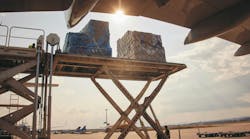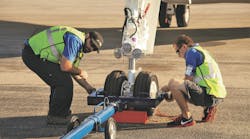The IATA Ground Handling Conference (IGHC) is the longest running international ground operations event and provides the ultimate platform for the ground handling community to develop business, network with industry leaders and drive change.
The 32nd annual event will be held in Madrid, Spain, May 26-29.
The IGHC keeps its delegate satisfaction rate high and in the past year it reached 96 percent in overall satisfaction, 94 percent for networking and business opportunities and 98 percent for the program, while it was attended by more than 800 delegates.
With such a positive record, the IGHC has demonstrated it is a premier event for the ground handling industry.
The IGHC delegates are key to the success of this event. Of the delegates, 50 percent represent ground handling providers and airports, 25 percent are airlines and the rest are comprised of manufactures, solution providers, suppliers, media and other delegates. Meeting the industry’s leaders is part and parcel of the IGHC with executive level positions forming more than half of the delegates. Airlines fuel the global economy and generate more than $700 billion (USD) in total revenue, create approximately 240,000 ground handling jobs and $59 billion (USD) in revenues for ground service providers and caterers.
IATA member airlines, representing 85 percent of global air traffic, are key players in terms of standards setting and business development. Therefore, their presence at the IGHC is beneficial to all attendees. On average, the IGHC is attended by more than 80 airlines from around the world with over 215 delegates.
Look to the Future Through the Present
The IGHC offers an exhibition, plenary sessions, workshops, business meetings, industry meetings, training courses and social events.
This year the IGHC is looking into the future through the present. Innovation, technology and sustainability are the key words and the program offers topics such as Ramp of the Future (RoF), sustainable ramp, the NEXTT program, growth of ground ops jobs, the future passenger journey, as well as regulatory framework, operational standards, safety polices, data sharing, security threats and others.
Among the high ranked industry representatives, Patrick Ky, executive director at EASA, will deliver a keynote on the regulatory framework and EASA’s roadmap for ground operations, which EASA is working on to ensure safety in ground operations. As per EASA’s recent press release, the organization will initiate a rulemaking task and a safety promotion task to reference the necessary requirements and initiate non-regulatory activities with the aim of increasing the level of safety in the ground handling domain.
Most of the innovation in aviation is aimed at improving the passenger travel experience by developing a series of services, infrastructures and tools either at the airport or to be used directly by the passengers prior to, during and after their travel. But what do we do on the ramp to prepare for the expected growth in passenger numbers? The Ramp of the Future session will present the new IATA project, which will define how advanced technology and advanced data processing can be interlinked and connected to deliver capacity improvements and enhanced processing of the aircraft turnaround operations. The project’s aim is to enhance three major areas on the ramp, namely:
- Digitalization of ramp services.
- Ground support equipment.
- Aircraft stand design.
The main benefit of this project is to enhance ramp safety and efficiency which is enabled by:
- Identifying relevant real-time operational data from multiple sources, collating it and sharing it in a way that will facilitate and support critical data-driven operational decisions.
- Utilizing data to facilitate and drive day-to-day operational decisions based on real-time information, such as equipment and personnel allocation to flights based on specific aircraft type/load quantity/passengers.
- Utilizing data records to analyze trends to optimize deployment of resources and facilitate assessment of equipment purchases.
- Reduce ramp vehicle congestion, aircraft and equipment fuel consumption and emissions by optimizing aircraft movements and vehicle sizes/capacities.
- Improve the quality of operations for airlines, airports and ground handlers and share the benefit of the various investments to best fit and cater for future demand.
In the passenger session, the topics of the one ID program, the biometric recognition and identity management in the passenger process will be tackled. As well, there will be discussions on how the future of the passenger process will look.
The sustainable ramp discussion will provide perspective on aviation’s role in the UN sustainable development goals, the industry’s climate action plan and the role of ground operations in these areas, on how to implement green airports, as well as how to get airports prepared for natural disasters and wild life trafficking.
Those in attendance will explore what types of equipment are available to make ramp operations more sustainable, the practices being implemented around the world, the drivers for this (airport and airline contractual changes, local communities, workforce, regulatory issues) and where the industry sees itself moving in this space: electric, autonomous, GSE and other vehicles, etc.
With a forecasted doubling of air traffic in the next 10 years, the demand for employees and their training becomes a hotter topic by the day. What the current status in the workforce is, what the future jobs are, how the future training will look and how training can help to retain employees will be discussed during plenary and workshop sessions.
IATA’s Resolution 753 on baggage tracking is now in effect, so IATA has included “Driving competitive advantage through RFID in baggage” – the session on what baggage services passengers can expect and the reasons why RFID in baggage could best meet their needs. Part of this session will be a case study showcasing an implementation and a panel where airlines and ground handlers will have an opportunity to discuss challenges and best practices to implement RFID globally.
IATA is moving to the next GEN of safety data sharing. The “Incident Data Exchange (IDX)” is IATA’s new incident database. This session will focus on key aspects of the new database, the importance of data sharing and data-driven decision-making. Delegates will be able to demo new dashboards as well as understand functionalities of the new data sharing platform.
Cargo is an essential topic at the IGHC. This year delegates will have opportunity to learn about the IATA Cargo Handling Manual (ICHM) – brother of the IATA Ground Operations Manual (IGOM). The session will zoom-in on the scope of the manual, its objectives as well as provide a practical tool on how to conduct the gap analysis between ICHM and the company GOMs to ensure compliance.
For the third time, the IGHC Innovator competition finalists will have the opportunity to present their solutions at the IGHC. The winner will be selected by the audience and announced on the last day.
The Innovation Bootcamp is attended by invited experts exploring emerging technologies and challenging the way we innovate. Outcomes will be presented on the final day.
The IGHC is the ideal platform to leverage the business opportunities, create revenues, and helps companies to build their reputation and relationships with current and prospective airlines, ground service providers, airports and suppliers.
To support delegates with their networking and helping to create business opportunities, IATA is introducing a few new enhancements.
IATA is introducing the IGHC BizZone. This is an area exclusively dedicated to the business meetings, where delegates can schedule meetings with their partners at a reserved meeting table by using the IGHC Event and Networking Tool. IATA will have a dedicated BizZone team on-site helping delegates with the meeting facilitation.
Also, for the first time, IATA will facilitate a speed networking session called “Getting to Know Your Airlines,” helping handlers and suppliers to open doors and to establish connections with member airlines. Delegates can schedule 15-minute meetings with various airlines during the course of the session. IATA has also introduced the Business Passes specifically for the IATA member airlines’ procurement managers and a new flat rate for members to support the airlines’ attendance.
And last, but not least, there will be the first Ground Operations Executive Summit (GOES) organized in parallel with the IGHC. This summit will be attended by ground operations top executives with the objective of agreeing on industry priorities and the IATA ground handling department’s strategic direction. Outcomes of this summit will help shape the industry agenda for ground operations and IATA priorities. A wide range of airlines and ground service providers confirmed their participation.
As it is every year, IATA training is an integral part of the IGHC. This year the association will offer an expanded range of various personal development and training opportunities, starting with the traditional SGHA course, through to A-CDM and emergency response trainings. IATA will also facilitate a complimentary security seminar “Catch the TRAM” focused on security threats, risks and audits.
An interesting fact about the IGHC is that it is not only one of the longest running IATA conferences, but it is organized by a small team of people, whose primarily responsibility is ground operations standard setting and global implementation – the IATA Ground Operations team, led by Joseph Suidan, head of ground operations. No matter that the teams’ expertise is in the operations and safety area rather than event management, their dedication to make this event a success every year is high.
IATA believes that it has prepared an interesting program and introduced many networking enhancements, which will contribute together with beautiful Madrid to the success of this year's IGHC. For more details, visit https://www.iata.org/events/ighc.
– This article was submitted by the International Air Transport Association





